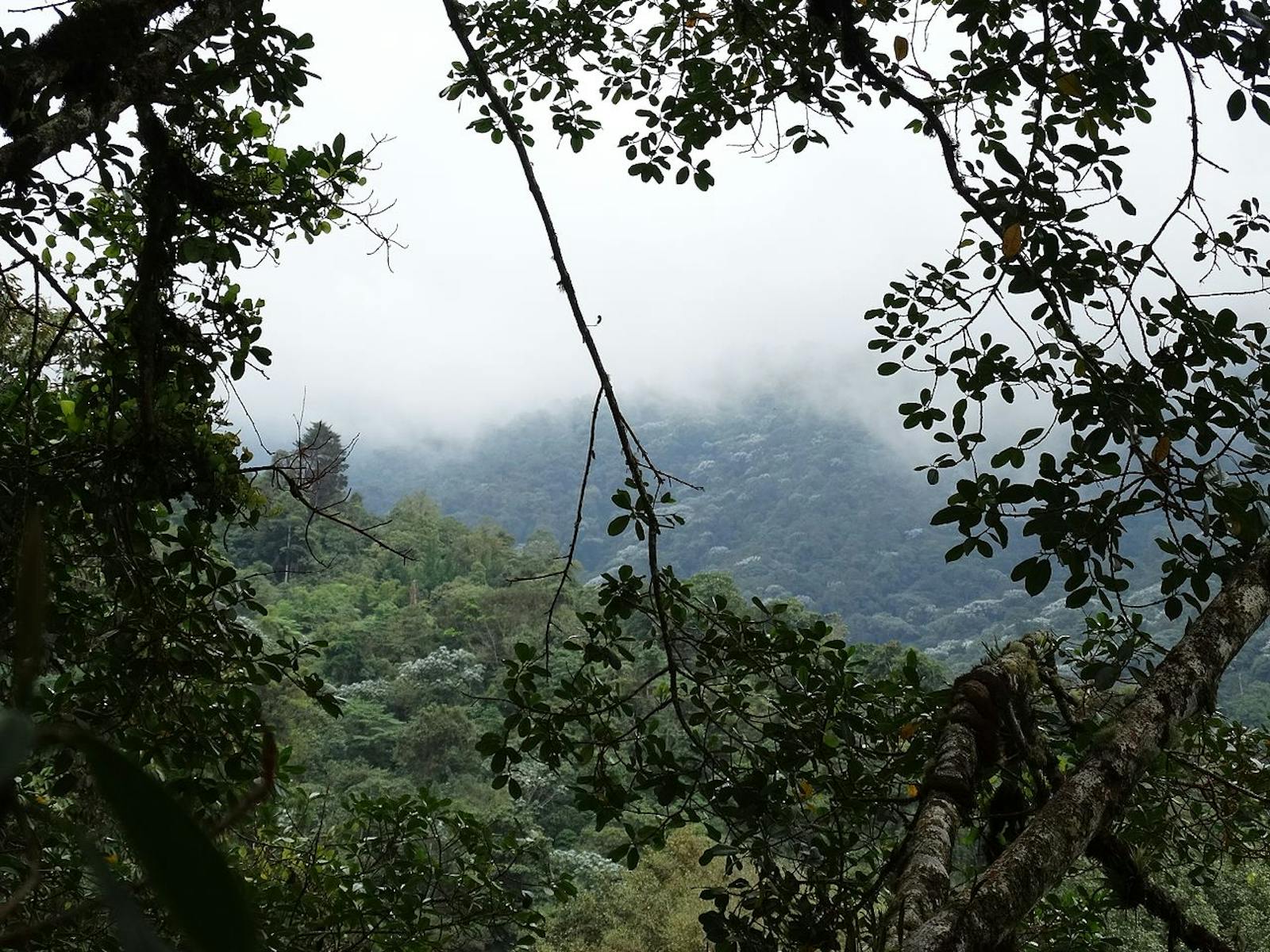Cauca Valley Montane Forests
The ecoregion’s land area is provided in units of 1,000 hectares. The conservation target is the Global Safety Net (GSN1) area for the given ecoregion. The protection level indicates the percentage of the GSN goal that is currently protected on a scale of 0-10. N/A means data is not available at this time.
Bioregion: Andean Mountain Forests & Valleys (NT11)
Realm: Southern America
Ecoregion Size (1000 ha):
3,213
Ecoregion ID:
448
Conservation Target:
67%
Protection Level:
2
States: Colombia
The Cauca guan, a large bird species with a unique red dewlap, is endemic to the Cauca Valley Montane Forest ecoregion. Found in the humid forests at elevations between 1,200 and 2,200 m, this large, grey-brown guan is often seen perching on branched in the middle to lower canopy where its size does not get in the way of navigating the complex canopy.
The bird finds safety in the darkness of the understory and is rarely seen out in the open; it feeds on seeds and insects and often drinks from bromeliads to avoid going to the forest floor, making them important seed dispersers for vines and trees. However, its unusual large size also makes it susceptible to hunting and with less than 1,000 mature individual in the wild, it is currently listed by the IUCN as Endangered.
Located at the northwestern end of the Andes Mountain Range in southwestern Colombia, the Cauca Valley is nestled between the western and central ranges of the Andes and stretches for 600 km in a south-north direction. The gentle slopes of the Cauca Valley foothills, starting at an elevation of 1,000 m, give way to an abrupt topography at higher elevations, with deep canyons and numerous rivers and streams that drain into the Cauca River. Elevations of the Central Andes reach over 5,000 m with several volcanoes and perpetually snow-capped peaks. The western Cordillera, lower and narrower than the central, reaches elevations of up to 4,000 m.
The vegetation communities are diverse in part to the sharp altitude changes and also due to a precipitation range with dry enclave foothills in the western Andes (500–1,000 mm/year) transitioning to humid montane forests in the central range (up to 3,000 mm/year). The humid forests of the lower elevations (1,500 m) are dominated by species of Leguminosae and Moraceae, while at middle elevations (1,500–3,000 m) Lauracea, Melastomataceae, and Rubiacea families are common. At higher elevations (above 3,000 m) the flora is dominated by species of Ericaceae and Asteraceae. The native palm species, Ceroxylon quindiuensis, is notable as the tallest recorded monocot, reaching 60m, and is national tree of Colombia, currently listed by the IUCN as Vulnerable.
.jpeg)
The flagship species of the Cauca Valley Montane Forests ecoregion is the Cauca guan. Image credit: Cristian Lopez, Creative Commons
The Cauca Valley Montane Forests ecoregion contains more than 500 species of birds, 92 species of frogs, 120 species of mammals, and 200 species of butterflies. This ecoregion is also a center of endemism for several plant and animal taxa and contains one of the Endemic Bird Areas determined by BirdLife International, with 12 restricted-range species in an area of 19,000 km2. Restricted-range and/or endangered bird species
include the Cauca guan, brown-banded and moustached antpittas, multicolored tanager, and golden-plumed parakeet. Of the 92 species of frog, 60 are endemic. This amazing range of diversity is attributed to the altitudinal range of the region and some cases of species isolation on different slopes. Some large mammals of interest include the spectacled bear and the mountain tapir.
The montane forests of the Cauca Valley are severely fragmented, especially at the lower elevations. Between 1,000 and 2,000 m, most forest has disappeared and only scattered remnants remain. The largest remaining block within this elevational belt is found in the Yotoco Forest Reserve, with an extension of 5.19 km2. Substantial forest cover still remains at the higher elevations, on both slopes of the valley. However, only small portions receive nominal protection in national parks such as Farallones de Cali, Tatamá, and Los Nevados. Some protection is also afforded by small regional reserves such as Ucumarí Regional Park.
The major threat to the ecoregion’s biodiversity is the continuing degradation of lands around and in already fragmented areas. The steep slopes of the valley also increase the possibility of landslides when forest is removed for agriculture. Some higher elevation areas are still being exploited for timber and other forest products. Illegal hunting is also a problem in the area, threatening mostly large birds such as the Cauca guan and mammals.
The priority conservation actions for the next decade will be to: 1) encourage regional forest restoration initiatives to protect remaining habitat fragments; 2) increase regulation in the continuing timber industry; and 3) increase enforcement and capacity to manage illegal hunting.
Citations
1. Kattan, G. 2018. Northern South America: Central Colombia. https://www.worldwildlife.org/ecoregions/nt0109 Accessed July 30, 2018.
2. Lynch, J. D., P. M. Ruiz, and M. C. Ardila. 1997. Biogeographic patterns of Colombian frogs and toads. Revista de la Academia Colombiana de Ciencias 21:237-248.
3. Bibby, C.J., N.J. Collar, M.J. Crosby, M.F. Heath, Ch. Imboden, T.H. Johnson, A.J. Long, A.J. Stattersfield, and S.J. Thirgood. 1992. Putting Biodiversity on the Map: Priority Areas for Global Conservation. International Council for Bird Preservation, Cambridge, U.K.
4. Gentry, A. H. 1982a. Neotropical floristic diversity: phytogeographical connections between Central and South America, Pleistocene climatic fluctuations, or an accident of the Andean origeny? Annals of the Missouri Botanical Garden 69:557-593.



